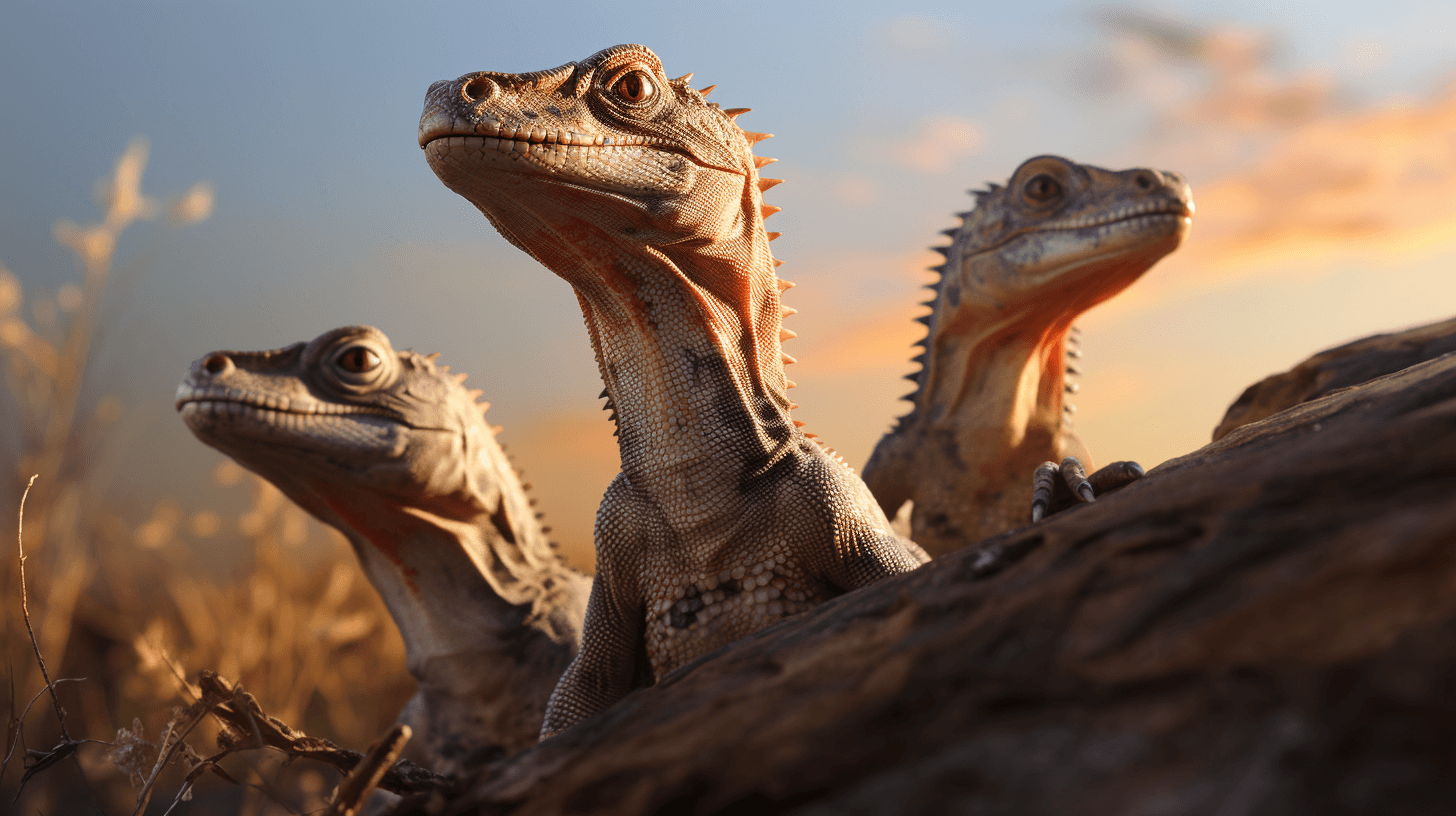🦕🤕 Da Fossils Show How Da Long-Necked Reptiles Lost Dey Heads
⬇️ Pidgin | ⬇️ ⬇️ English
Da discovery show dat long necks, which wen help some prehistoric reptiles catch food, was one big bullseye fo’ da predators. In 1830, dis English paleontologist guy named Henry De la Beche, he wen paint “Duria Antiquior,” one vision of da Mesozoic oceans. When he wen draw one long-necked marine reptile, he wen show da neck get caught up between da jaws of one huge Ichthyosaurus. 🖌️🌊🦖
Almost two centuries pass and still no solid proof dat backs up De la Beche’s idea of da neck biting. But dis new research wen come out on Monday, in one journal called Current Biology, an’ it wen provide gory — an’ really rare — evidence dat da predators wen see da long, stretched out necks of da reptiles swimming around da prehistoric seas as irresistible targets. 😱🌊🦖
Da victim was Tanystropheus, and dis reptile’s neck stay “one-of-a-kind” in da fossil records, according to dis paleontologist dude named Stephan Spiekman. He work at da State Museum of Natural History in Stuttgart, Germany, and he one author of da study. Da neck structure, which make up half of da animal’s body, stay made from 13 bizarrely long and interlocking bones, so da neck stay stiff like one fishing pole. 🦕🦴
“Getting any kind insight into how dis extreme structure work, wit’ all da strengths and weaknesses, stay super important,” Dr. Spiekman say. 🧪🦴
Dr. Spiekman wen do his doctorate research, and he find out dat had two different species of Tanystropheus — one small one, and one dat was almost 20 feet long. Dey stay living in da shallow lagoons of da Triassic Alps, and most likely dey stay hunting fish from da seafloor. During his research, he wen study two specimens from each species, and all he wen find was da head and da neck. 🎓🦖
In both animals, “da neck wen break in da back half,” Dr. Spiekman say. “It’s like wen you snap one broomstick.” 🚫🦴
Dr. Spiekman wen show his office mate, Eudald Mujal, da specimens. Dis guy, he one paleontologist too, and he wen specialize in looking at how predators and prey interact in da fossils, especially da bite marks on da bones. After dey spend one afternoon checking out da fossils in Zurich, dey wen conclude dat da necks wen get bitten apart. 💀🔍🦴
“Da broken parts of da bones look like when you break one chicken bone,” Dr. Mujal say. “Da bone wen break wen it was still fresh, and most likely when da animal still stay alive.” 💔🍗
Da team wen measure da distance between da bite marks on da bigger Tanystropheus, and den dey wen compare ’em wit’ da jaws of different predators dat stay in da same habitat. Da most likely suspect was one big nothosaur — kinda like ancestors of da plesiosaurs — o’ one of two big, predatory ichthyosaurs, Dr. Mujal say. Da smaller Tanystropheus maybe wen get attacked by one small marine reptile o’ one big fish. 🐉🐠🦴
Both animals probably got hit from above, dateam wen find out, so da predators wen moa interested in da meaty bodies instead of da skinny necks o’ small heads. “Dey probably wen target da same area of da neck,” Dr. Mujal say, “far enough from da head dat da animal no can defend itself.” 🎯🦖🍖
Tanystropheus stay da only marine reptile dat wen suffer from dis kind of brutal decapitation. Da long necks of da plesiosaurs — reptiles dat wen come aftah Tanystropheus wen go extinct, but stay around till da end of da Mesozoic period — stay made up of plenny bulky bones, all surrounded by muscle and blubber, Dr. Mujal say. Even if dey wen get attacked, “da neck stay covered by one thick layer of flesh and skin, so da predators maybe no leave any marks on da bones.” 🐢💪🦴
But no mattah if da long neck stay one weak spot fo’ da predators, da researchers point out dat it stay one incredible evolutionary strategy. Plenny different groups of marine reptiles dat eat fish wen independently evolve dem elongated necks fo’ moa den 175 million years. Tanystropheus and its ohana stay one success story too, spreading all ova da Triassic shorelines from Europe to China, and sticking around fo’ 10 million years. 🌊🦕🌍
“Evolution stay one game of give and take,” Dr. Spiekman say. “In da long run, da risk of having one long neck stay worth it fo’ dis animal.” 🔄🦖
In oddah words, sometimes you gotta stick yo’ neck out even if da risk stay getting yo’ head bitten off.
NOW IN ENGLISH
🦕🤕 Fossils Show How Long-Necked Reptiles Lost Their Heads
The discovery suggests that long necks, which helped some prehistoric reptiles catch food, were tempting targets for predators. In 1830, Henry De la Beche, an English paleontologist, composed a painting of “Duria Antiquior,” a vision of Mesozoic oceans. When picturing a long-necked marine reptile, he depicted its throat clamped between the jaws of a monstrous Ichthyosaurus. 🖌️🌊🦖
Almost two centuries have passed without direct evidence of the neck biting De la Beche imagined. But research published Monday in the journal Current Biology has provided gory — and extremely rare — evidence that predators saw the lengthy, outstretched necks of reptiles swimming around prehistoric seas as an irresistible target. 😱🌊🦖
The victim was Tanystropheus, whose neck is “completely unique” in the fossil record, said Stephan Spiekman, a paleontologist with the State Museum of Natural History in Stuttgart, Germany, and an author on the study. The structure — which made up half the animal’s body — was constructed from 13 bizarrely elongated and interlocking vertebrae, creating a neck as stiff as a fishing rod. 🦕🦴
“Getting any insight into how these extreme structures functioned with potential weakness and strengths is very important,” Dr. Spiekman said. 🧪🦴
Dr. Spiekman’s doctoral research revealed that two separate species of Tanystropheus — one small, another almost 20 feet long — lived in the shallow lagoons of the Triassic Alps, most likely hunting fish from perches on the seafloor. In the course of that research, Dr. Spiekman studied a pair of specimens from both species, each composed solely of a head and neck. 🎓🦖
In both animals, “the neck is broken in the back half,” Dr. Spiekman said. “It’s like snapping a broomstick.” 🚫🦴
Dr. Spiekman shared the specimens with his office mate, Eudald Mujal, a paleontologist who specializes in analyzing predator-prey interactions in fossils, particularly bite marks on bones. After an afternoon with the fossils at their resting place in Zurich, they concluded that the necks had been bitten apart. 💔🔍🦴
“The broken portion of the bones look like if you break a chicken bone,” Dr. Mujal said. “The bone was broken when it was still fresh, and most likely while the animal was still alive.” 💀🍗
The team measured the distance between bite marks on the larger Tanystropheus and compared them with the jaws of various predators sharing the habitat. The likely culprit was either a large nothosaur — seal-like ancestors of plesiosaurs — or one of two large, predatory ichthyosaurs, Dr. Mujal said. The smaller Tanystropheus may have been attacked by a smaller marine reptile or a large fish. 🐉🐠🦴
Both animals had most likely been struck from above, the team concluded, possibly by a predator interested more in their meaty bodies than their spindly necks or tiny heads. “They’re possibly preferentially targeting the same region of the neck,” Dr. Mujal said, “far enough away from the head to make it hard for the animal to defend itself.” 🎯🦖🍖
Tanystropheus is the only marine reptile known to suffer such unceremotional decapitation. The long necks of plesiosaurs — reptiles that emerged after Tanystropheus went extinct and lingered until the end of the Mesozoic period — are made up of many bulky vertebrae, all buried in muscle and blubber, Dr. Mujal said. While they may also have gotten it in the neck, “a very thick layer of flesh and skin around the neck means that predators might not have left any marks on the vertebrae.” 🐢💪🦴
But even if the long neck was a weak spot for predators, the researchers note, it was clearly a remarkably successful evolutionary strategy. Many different groups of fish-eating marine reptiles independently evolved elongated necks over 175 million years. Even Tanystropheus’s family proved a success story, spreading across Triassic shorelines from modern Europe to China and lasting for 10 million years. 🌊🦕🌍
“Evolution is a game of trade-offs,” Dr. Spiekman said. “In the long run, the risk of having a long neck was worth it for this animal.” 🔄🦖
In other words, sticking your neck out can be worth it for the species — even if you personally get your head bitten off.







